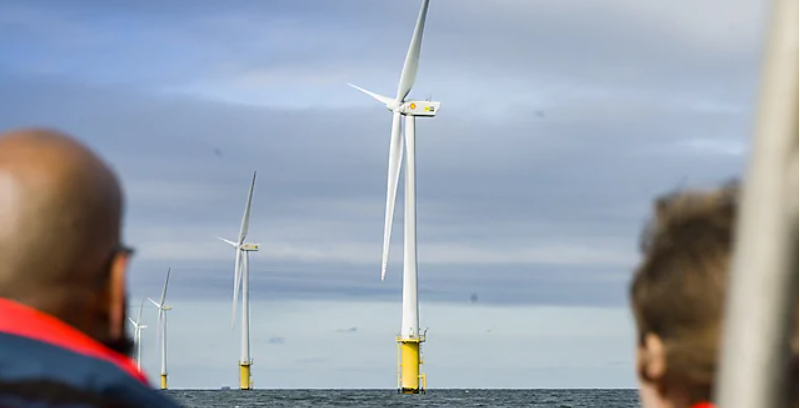The Covid-19 pandemic has posed many challenges to the maritime industry, but it has also given it time to think to the future, and that future is looking strong in renewable energy.
At a hearing before a congressional committee on Feb. 9, Michael Roberts, senior vice president at Jacksonville, Fla.-based Crowley Maritime and president of the American Maritime Partnership, a maritime legislative coalition, told lawmakers that offshore wind “is one of the most important emerging markets for our industry.”
Offshore wind will produce “tens of thousands of jobs, tens of billions of dollars in economic output and play a significant role in decarbonizing electricity production in the United States,” Roberts said, adding that “American maritime is excited to be playing a key role in realizing those expectations.”
After several years of inconsistent messaging about offshore wind development from the Trump administration, Roberts and others said that wind power now has a clear path forward under President Biden, who has given a strong endorsement to it and to the role to be played by American mariners and ships in its development.
Just a few days after taking office, Biden signed the Buy American executive order which confirmed that the Jones Act is “an opportunity to invest in America’s workers as we build offshore renewable energy, in line with the President’s goals to build our clean energy future here in America.”
At about the same time, the FY2021 National Defense Authorization Act was coming into force, which states that all American laws, including the Jones Act, will apply to offshore wind development on the Outer Continental Shelf.
These were highly significant endorsements that will give a solid boost to the offshore wind market and encourage investment in this technology, providing the maritime industry with “the certainty needed to invest in long-term offshore wind assets,” Roberts said.
Roberts added that investments in vessels and other assets is expensive and are made for the long-term, so the industry needs to know that the market for vessels and services will be strong going forward, and that American industry and mariners will benefit.
“We make those investments in reliance on U.S. law as it stands today and as it has generally stood for over 100 years,” he said, referring to the Jones Act, which requires that cargo moved by water between two points in the United States be transported on American vessels crewed by U.S. mariners.
“With this confirmation and the promise of a large new market for American assets, operators are already beginning their investments in ships to meet emerging needs,” he continued, citing the design of the first Jones Act compliant vessel for subsea rock installation by Great Lakes Dredge and Dock. In addition, he said,
Dominion Energy recently announced the start of construction for the first Jones Act complaint offshore wind turbine installation vessel, which is expected to support wind turbine installs by the end of 2023, while other companies are building service operation vessels to support offshore wind development off the East Coast.
Robert called the potential wind farm market “enormous, with 19 offshore wind projects off the East Coast already planned.” These farms will provide more than 2,100 wind turbines that will produce some 30 gigawatts of electrical power when fully operational by 2030. He cited projections by the American Wind Energy Association that these farms will eventually produce $57 billion in investment and 45,000 to 83,000 jobs by 2030, with additional projects likely in the Atlantic, Gulf and Pacific coasts.
He said while the U.S. lags behind the European Union and the U.K. in offshore wind development, it can learn much from their experiences and benefit from development of more powerful turbines.
To be successful in the U.S., Roberts said “prudent government policies” will be needed, such as more predictable permitting processes, a possible regional approach to local content requirements, prompt Coast Guard regulatory action on offshore wind installation and service vessels and support and planning for necessary port infrastructure.
Meanwhile, he said U.S. shipping is becoming more green, with more investments in vessels that use cleaner fuels. He said TOTE Maritime and Crowley recently built new state-of-the-art ships powered by liquified natural gas (LNG) for routes in Puerto Rico. Meanwhile Matson Navigation Co., based in Hawaii, took delivery of one of two roll-on, roll-off ships that were built to run on a dual use LNG system. Fueling ships with LNG will greatly reduce carbon emissions compared to fossil fuels, he said, while other fuel alternatives are also being developed.
“Given the very substantial benefits LNG provides in reducing overall emissions as compared to conventional marine fuels, U.S. policies should support the use of LNG as we transition toward a carbon-free future,” Roberts said.
The march toward a greener maritime industry is already well underway, he said, as naval architects and engineers are designing new innovations and thousands of workers in shipyards and related businesses are building these new vessels.
Mariners must also be trained in these developing technologies, he told lawmakers, as there will be many new jobs installing offshore turbines and the undersea cables that link the turbines back to shore, as well as building and operating specially-built vessels to service the turbines during construction and later for maintenance.
The future is indeed looking better. Covid-19 infections and hospitalizations are coming down across the country, and despite huge job losses caused by the pandemic, the maritime industry is working and finding new opportunities to expand and serve the country.




